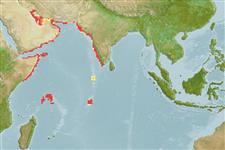Ikan bertulang rawan (sharks and rays) >
Orectolobiformes (Carpet sharks) >
Hemiscylliidae (Bamboo sharks)
Etymology: Chiloscyllium: cheilos (Gr.), lip, referring to membranous and broad lower lip, presumably of C. plagiosum (proposed without a species); skylion, Greek for dogfish or small shark. (See ETYFish); arabicum: -icus (Gr.), belonging to: Arabian (Persian) Gulf, between Iran and Arabian Peninsula, where it occurs. (See ETYFish).
Environment: milieu / climate zone / depth range / distribution range
Ekologi
laut dasar (demersal); kisaran kedalaman 2 - 100 m (Ref. 43278). Subtropical; 31°N - 8°S, 45°E - 78°E (Ref. 54325)
Western Indian Ocean: India, Pakistan, and the Persian Gulf between Iraq and the Arabian Peninsula.
Length at first maturity / Size / Weight / umur
Maturity: Lm 49.5, range 45 - 54 cm
Max length : 62.0 cm TL jantan/; (Ref. 121648); 89.0 cm TL (female); Berat maksimum terpublikasi: 645.00 g (Ref. 121648); Berat maksimum terpublikasi: 645.00 g
deskripsi pendek
Kunci identifiaksi (pengenalan) | Morfologi | Morfometrik
Duri punggung (Keseluruhan (total)) : 0; Duri dubur: 0. Mouth well in front of eyes; spineless dorsal fins far posterior on tail; greatly elongated thick precaudal tail, long and low anal fin just anterior to caudal fin, prominent predorsal and interdorsal ridges on back, dorsal fins with nearly straight posterior margins, first dorsal-fin origin opposite or just behind pelvic fin insertions, second dorsal fin usually with a longer base than first; no color pattern (Ref. 43278).
Inhabits coral reefs, rocky shores, and mangrove estuaries. Free-living at 10.1 cm TL. Feeds on squid, shelled molluscs, crustaceans, and snake eels (Ref. 43278). Oviparous (Ref. 50449). Of minimal interest to fisheries (Ref. 43278). Caught rarely by demersal trammel and trawl fisheries operating inshore. Utilized for its meat and possibly fins, but of limited value due to its small size (Ref.58048).
Oviparous. Embryos feed solely on yolk (Ref. 50449). Distinct pairing with embrace (Ref. 205). Lays up to four egg-cases on coral reefs which hatch after 70-80 days (Ref. 43278).
Compagno, L.J.V., 1984. FAO Species Catalogue. Vol. 4. Sharks of the world. An annotated and illustrated catalogue of shark species known to date. Part 1 - Hexanchiformes to Lamniformes. FAO Fish. Synop. 125(4/1):1-249. Rome, FAO. (Ref. 247)
Status IUCN Red List (Ref. 130435)
ancaman kepada manusia
Harmless
penggunaan manusia
Perikanan: nilai komersial kecil
Alat, peralatan
laporan khas
muat turun XML
Sumber internet
Estimates based on models
Preferred temperature (Ref.
123201): 23.5 - 28.5, mean 26.9 °C (based on 144 cells).
Phylogenetic diversity index (Ref.
82804): PD
50 = 0.5039 [Uniqueness, from 0.5 = low to 2.0 = high].
Bayesian length-weight: a=0.00398 (0.00290 - 0.00547), b=3.04 (2.95 - 3.13), in cm total length, based on LWR estimates for this species (Ref.
93245).
Trophic level (Ref.
69278): 4.1 ±0.55 se; based on food items.
Daya lenting (Ref.
120179): Rendah, Waktu penggandaan populasi minimum 4.5 - 14 tahun (Fec assumed to be <100).
Fishing Vulnerability (Ref.
59153): High vulnerability (56 of 100).
